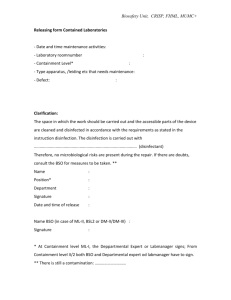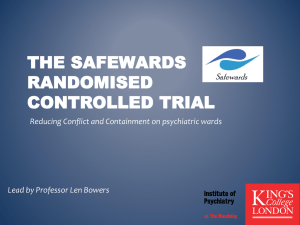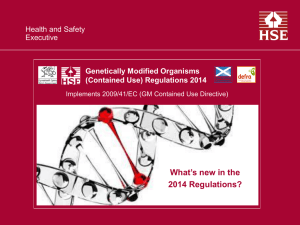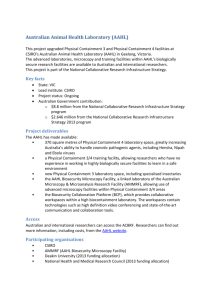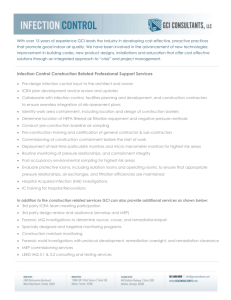Cost Containment 06 - University of Virginia
advertisement
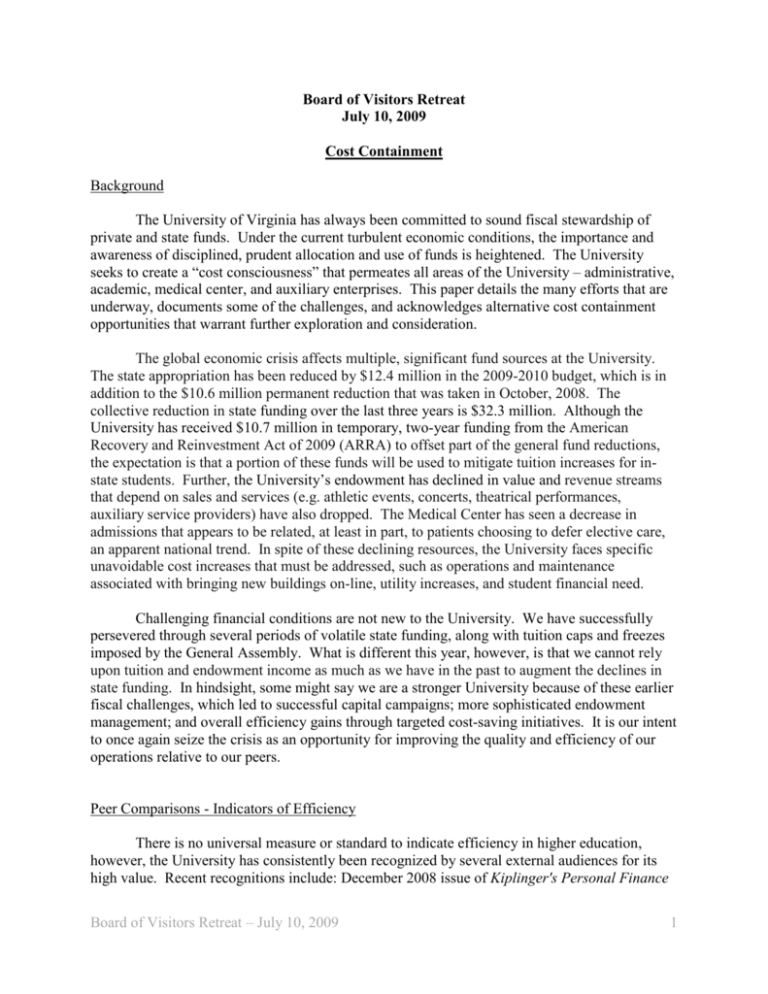
Board of Visitors Retreat July 10, 2009 Cost Containment Background The University of Virginia has always been committed to sound fiscal stewardship of private and state funds. Under the current turbulent economic conditions, the importance and awareness of disciplined, prudent allocation and use of funds is heightened. The University seeks to create a “cost consciousness” that permeates all areas of the University – administrative, academic, medical center, and auxiliary enterprises. This paper details the many efforts that are underway, documents some of the challenges, and acknowledges alternative cost containment opportunities that warrant further exploration and consideration. The global economic crisis affects multiple, significant fund sources at the University. The state appropriation has been reduced by $12.4 million in the 2009-2010 budget, which is in addition to the $10.6 million permanent reduction that was taken in October, 2008. The collective reduction in state funding over the last three years is $32.3 million. Although the University has received $10.7 million in temporary, two-year funding from the American Recovery and Reinvestment Act of 2009 (ARRA) to offset part of the general fund reductions, the expectation is that a portion of these funds will be used to mitigate tuition increases for instate students. Further, the University’s endowment has declined in value and revenue streams that depend on sales and services (e.g. athletic events, concerts, theatrical performances, auxiliary service providers) have also dropped. The Medical Center has seen a decrease in admissions that appears to be related, at least in part, to patients choosing to defer elective care, an apparent national trend. In spite of these declining resources, the University faces specific unavoidable cost increases that must be addressed, such as operations and maintenance associated with bringing new buildings on-line, utility increases, and student financial need. Challenging financial conditions are not new to the University. We have successfully persevered through several periods of volatile state funding, along with tuition caps and freezes imposed by the General Assembly. What is different this year, however, is that we cannot rely upon tuition and endowment income as much as we have in the past to augment the declines in state funding. In hindsight, some might say we are a stronger University because of these earlier fiscal challenges, which led to successful capital campaigns; more sophisticated endowment management; and overall efficiency gains through targeted cost-saving initiatives. It is our intent to once again seize the crisis as an opportunity for improving the quality and efficiency of our operations relative to our peers. Peer Comparisons - Indicators of Efficiency There is no universal measure or standard to indicate efficiency in higher education, however, the University has consistently been recognized by several external audiences for its high value. Recent recognitions include: December 2008 issue of Kiplinger's Personal Finance Board of Visitors Retreat – July 10, 2009 1 Cost Containment magazine ranked U.Va. No. 3 in its "100 Best Values in Public Colleges; Princeton Review (2009) - #1 best value public institution (#4 in 2007; #7 in 2006); U.S. News & World Report (2009) - #2 public university, #23 overall, #16 in “Great Schools, Great Prices” category; Forbes (May 2008) - #1 among all national public universities by the Center for College Affordability and Productivity. In general, these rankings cite the University’s strengths of high academic quality, comprehensive financial aid program, efficient operations, and unusually significant endowment and fundraising operation, especially for a public institution. Further, an analysis of the components of the 2009 U.S. News & World Report's college and university rankings demonstrates the University’s efficient use of resources compared to its peers. Generally, institutions that rank high in the US News and World Report reputation measure also rank high in the expenditures per student measure. The extent to which an institution with a low expenditure ranking can attain a high reputational ranking could be an indicator of the efficient and effective use of resources. The graph below shows the numerical difference between the Expenditures per Student ranking and Peer Assessment ranking (reputation). During each of the past 11 years, U.Va. has performed well above its peers in this measure. No peer institution has been able to attain such a high peer assessment with such a limited budget. Institutional Expenditures Ranking vs Reputation Ranking (Peer Assessment) 55 50 45 Virginia 40 Berkeley 35 30 25 Michigan 20 15 10 UNC Peer Cornell UCLA 5 0 Penn Duke -5 -10 Vanderbilt -15 199 200 200 200 200 200 200 200 200 200 200 While the record reflects the fact that U.Va. operates in a relatively efficient manner, there is always opportunity for improvement. New technologies, improved and simplified processes, and a careful assessment of how we use resources can lead to savings and increased allocations of resources to our primary programs of teaching, research, service and health care. Board of Visitors Retreat – July 10, 2009 2 Cost Containment Best practices and the current economic environment require that we leave no stone unturned in our effort to provide the highest quality products at the most reasonable price possible. Cost Containment Approaches In response to the most recent budget reductions, we have implemented the more traditional, conventional strategies of holding positions vacant, deferring discretionary expenditures, and asking staff to take on more responsibilities; however, given the magnitude of repeated cuts, we recognize that incremental, one-time cuts and contingency plans are insufficient. This crisis requires us to respond with sustainable reductions. General approaches have included centralization or decentralization of functions or processes in order to achieve greater effectiveness and efficiency; consolidation of efforts to eliminate redundancy; outsourcing; resource sharing; and increased cross-institutional collaboration. As part of the 2009-2010 annual budget development process, each unit was required to submit a spreadsheet describing each reduction action, the associated operational impact of the action, and the explicit dollar amount reduction and FTE reduction if applicable. While traditionally cost control efforts have concentrated on administrative operations in both academic and administrative departments, ultimately all University functions must be scrutinized, even core functions of teaching, research and health care. Beyond containing cost and cutting costs, we are simultaneously exploring new and creative ways to generate additional revenue. We have not been insular in our approach to cost containment and have benchmarked best practices at other institutions, including Penn State -- University Cost Saving Task Force; the University of North Carolina System – President’s Advisory Committee on Efficiency and Effectiveness; University of Florida – Cost Reduction and Efficiency Task Force; Harvard University – Cost Savings Program; University System of Maryland – Effectiveness and Efficiency Work Group; University of Michigan -- Cost Savings Initiatives; and University of Central Oklahoma – Lean Thinking. In reviewing these approaches, we have concluded that we are engaged in similar efficiency efforts as our peers. In fact, many of the efforts that other institutions are initiating have been long-standing practices at the University. We will continue to monitor the work at other institutions and consider additional innovative cost containment strategies for application at U.Va. as appropriate. Several peer institutions have responded by establishing formal groups, task forces, or initiatives to facilitate cost containment across the institution. From 2002 – 2004, the University had a cross-functional working group, known as FOCUS, charged to identify opportunities to consolidate or eliminate services and programs and institute greater efficiencies. Over the last three years, we considered re-establishing this workgroup but determined that sufficient structures were already in place to facilitate this work and ultimately, we aspire to have everyone dedicated to this way of thinking, not just a committee or task force. Additionally, Process Simplification in the Office of the Vice President for Management and Budget serves as the University’s formal, systematic approach to continuous improvement. Process Simplification, established in 1994, is a pan-University improvement effort, which seeks to enhance the quality, effectiveness, and efficiency of processes that affect faculty, staff, and students. As such, specific project outcomes include the simplification of steps in a process, the elimination of Board of Visitors Retreat – July 10, 2009 3 Cost Containment duplicative efforts, and optimization of available resources. This effort has facilitated significant, tangible improvements over the years in administrative areas, student services, and academic administrative support areas. In times of financial pressure, outsourcing of services often receives increased attention. We continually assess the viability of outsourcing various activities and services. There are numerous factors to consider when evaluating the merits of outsourcing as opposed to selfoperation or a hybrid model, only one of which is cost. It is a delicate matter to ensure that the needs of the institution can be met at a lower cost than what it would cost the University to deliver. Examples of services which the University outsources include: dining, mail, some custodial, vehicle rental, transcription, child care, arena management, and pest control. . We continue to evaluate periodically services that would be appropriate to outsource. Looking long-term we are developing resource management strategies and practices to control costs in the future. For example, the Commission on the Future of the University initiatives are funded with seed money with the expectation that other revenue sources will be identified to support the activity in the long-term – i.e., after about three years. We are also becoming more objective and disciplined in using performance measures to gauge the level of success and progress of the Commission initiatives as well as other University activities. As such, we realize that we can’t simply keep doing more, growth by addition, but rather in some cases we have to stop doing things in order to support new activities. Growth by substitution and reallocation of resources must become a standard operating reality. Repatriation has been an important strategy over the last two years. Examples of Cost Containment The following examples are provided to demonstrate the breadth and depth of our cost consciousness across academic and administrative areas. Workforce Management Seventy- five percent of the University’s E& G budget (62% of the Academic Division budget) is expended on personnel. Our history shows that we have focused on predicting state budget weakness with a fair degree of success before any official notices are issued, taking steps on our own to manage the workforce and creating vacancies and related savings before Governors take action. The University has been able to avoid layoffs through early detection of the problem and several efforts to right-size our workforce. We are reducing staff numbers through attrition, consolidation of units, and job sharing. Human Resources has implemented an internal system to facilitate the transfer and reassignment of employees and mandated posting of positions internally prior to external posting. Each unit has an approved staffing plan that it must adhere to in managing its workforce. For example as a result of these efforts, employment levels in the administrative areas have been reduced by approximately 100 permanent positions, an average net reduction of 4%. The level of reduction percentage varies by unit and spans 3% to 9%.As new or replacement positions are hired, salaries are to be at established levels equivalent to or below the salary of the person being replaced unless a higher salary has been justified in advance. These potential replacement savings are particularly notable in the academic division Board of Visitors Retreat – July 10, 2009 4 Cost Containment when one considers replacing a retiring full professor with an assistant or associate professor. In general, professors are paid more than associate professors and associate professors are paid more than assistant professors. The savings realized when a full professor terminates his employment and a school replaces him with a new assistant professor is approximately $38,500 in Arts and Sciences, $29,000 in Engineering; and $28,700 in Medicine. An analysis of aggregated data from 2005-2008 demonstrates that schools do, in fact, replace full professors with assistant and associate professors. Efficiency of Teaching (Provost Office should review) On the academic side, we are examining the efficiency of teaching through a comprehensive analysis of faculty loads, courses, and class sizes. Conventionally, research and instruction have been considered as a bundled cost. This review is focused on individual faculty teaching productivity. As a result of this analysis, there will be opportunities to eliminate duplication of similar courses in different programs and schools and realize efficiencies where instructional costs are fixed (e.g. additional students with less-than-proportionate cost increases). For example, the School of Arts and Sciences will reduce the number of courses offered in 20092010 by approximately 43. Consolidation We are studying the feasibility of consolidating the Housing Division facilities staff of approximately 100 and the small Newcomb facilities staff with the Facilities Management organization of 950 staff. Thus far, we have determined that it is feasible to consolidate and are considering the advantages and disadvantages of doing so. As a result of these consolidations the University will be able to leverage fully the depth of resources, efficiency, and flexibility offered by a large organization, and Housing and Newcomb will realize savings in maintenance costs. It is estimated that these savings will yield approximately $450,000 by the third year. Outsourcing ITC Help Desk - The University has secured a vendor to assume responsibility for a single unified IT help desk. PerceptIS is a Cleveland-based firm with a reputation for excellence in IT customer service for higher education, non-profit, and commercial markets. Currently, the University maintains three separate help desks - ITC help desk, Integrated System help desk, and a Student System help desk. As a result of this outsourced solution, services will be enhanced to include 24/7/365 support to the University community via email, phone, chat, and online selfservice. System maintenance will pay for outsourced vendor at an expected cost lower than current and future estimated costs of the current help desk configuration. (Insert actual dollars). Medical Center The Medical Center, in consultation with the School of Medicine, has identified nine initiatives which represent opportunities to reduce operating costs or increase operating margin with a potential impact of improving the operating margin by $17-38 million. Each of these items will require significant engagement of clinicians and health care professionals. Consequently, the engagement of the Vice President and Chief Operating Officer of the Medical Center and the Vice President and Dean of the School of Medicine is essential. Rector Fralin asked that efforts be made to find means of increasing annual payments to the School of Medicine from the current Board of Visitors Retreat – July 10, 2009 5 Cost Containment $62 million to a total closer to $100 million, to be used primarily for research – these nine initiatives are in response to that inquiry. Leveraging Market Opportunities - Expedited Construction The University has accelerated the construction of Phase III (the next two buildings) of the Alderman Road Housing replacement project as a result of a favorable bid on Phase II ($25.4 million below the authorized budget). The estimated completion date of the project is expected to be a year earlier than planned. Athletics Athletics has focused on identifying sustainable changes in its business practices. Changes implemented to produce the needed cost savings include a 4.5 percent operating budget reduction to non-personnel budgets, strict travel guidelines for both team and professional development ($380,000), re-negotiation of the athletic meal plan ($250,000), and venue change for night before home games ($35,000). (Melissa Clarke to provide details) Specific Examples of Revenue Generation Over the years Procurement Services has regularly sought to cost save and cost avoid through daily competition and negotiation and in doing so has saved the University millions of dollars. More recently the department has turned its attention to generating revenue. Several initiatives are underway to leverage the marketplace, the current economic conditions, and an increased reliance on technology. Procurement has negotiated discounts for cash or early payments. Suppliers that want to receive payment in less than 30 days may offer a discount. There are over 500 suppliers offering discounts, which range from 0.5% to 5% of the total cost. In the next fiscal year, these discounts are estimated to equal about $75,000. Procurement has also contracted with Bank of America, the University’s commercial bank contractor, to implement electronic payment options for suppliers. If a supplier is paid via a credit card the University receives a rebate for that payment. In its first year of implementation, the rebates have totaled $440,000. Numerous other initiatives are being implemented, such as additional rebates and user fees for our contracts, rebates for enabling suppliers to accept electronic purchase orders, the ability to submit electronic invoices and accept payment electronically. As a result of all of the efforts, it is estimated that in fiscal year 2009-2010 Procurement will generate $1,000,000 in revenue. Ultimately, Procurement Services aspires to generate annual revenues that total or surpass its unit operating budget. Strategies for the Future It is widely acknowledged that higher education is a labor-intensive enterprise and one in which new investments are typically expensive. In order to position the University to make strategic new investments unrestricted resources must be created either through revenue generation or cost containment. Board of Visitors Retreat – July 10, 2009 6 Cost Containment Implement annual across-the–board budget reductions as part of the budget development process As we seek effective cost containment strategies, it is important to recognize that in a decentralized environment, many of the decisions that affect productivity in the academic division are made at the decentralized school and unit level. Without a catalyst, units may not voluntarily examine cost containment strategies that could be employed in their areas. Some institutions, Penn State, Michigan State, and the University of Michigan to name three, repatriate a certain percentage of the operating budget annually to support University-wide priorities and initiatives. The tax encourages units to look for ways to eliminate redundancy and complexity and provides a pool of resources for reallocation. This activity becomes part of the annual budget development process so that units know they must be constantly looking for ways to improve productivity and efficiency. Focus cost containment efforts in several key areas Rather than repatriating a given percentage of the operating budget from each unit the University could identify several key areas in which the potential for cost reduction is the greatest. Work groups could be established to gather data on each area, evaluate alternatives, and make recommendations with the main objective being cost reduction. Such a strategy has the potential to affect some units at the exclusion of others. In other words, the pain is not spread like peanut butter, but rather strategically focused. Ask units to identify their lowest priority activities with the objective of identifying those that can be eliminated The hardest thing to do in higher education is to decide what not to do. Even when faced with significant budget reductions, schools and departments often elect to reduce services or ask faculty and staff to do more and rarely elect to eliminate entire programs or services. The University could focus its attention on identifying services and programs that could be eliminated freeing up the resources currently invested in them to put toward new priorities. Questions for Discussion Should the University consider an across the board “efficiency tax” or “give back” on each unit’s annual budget? As an alternative, should the University identify several areas that offer the greatest potential for cost savings; study those areas intensively; and produce an action plan that will produce resources that can be reallocated to higher University priorities? Since we are operating at lower cost because of our cost containment efforts, what policies must we have in place when the revenue streams rebound in order to best position the University to address important strategic objectives in the future by focusing the allocation of new resources? What strategies are available to generate new revenue for the University? Board of Visitors Retreat – July 10, 2009 7

